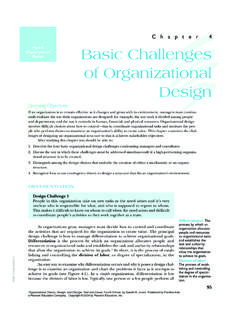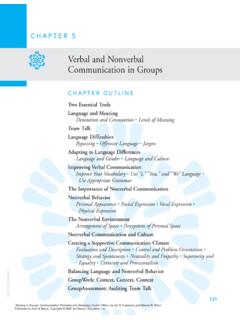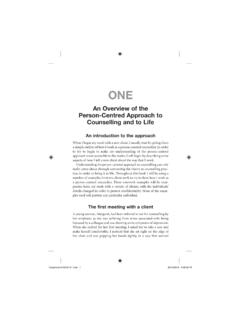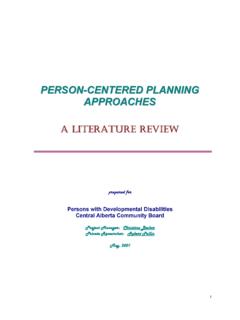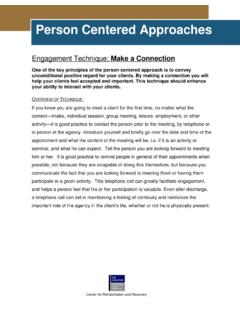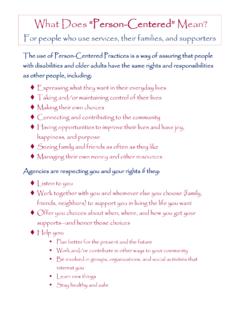Transcription of THE CURRENT STATUS OF CARL ROGERS AND THE PERSON …
1 THE CURRENT STATUS OF carl ROGERS AND THEPERSON- centered APPROACHHOWARD KIRSCHENBAUM AND APRIL JOURDANU niversity of RochesterThis investigation of carl ROGERS swork explores the CURRENT STATUS of theclient- centered / PERSON - centered ap-proach within the United States andinternationally. The STATUS is revealed1st by the volume of PERSON -centeredliterature that has been published sinceRogers s death in 1987. The prevalenceof ROGERS s work is also measured inthe number of professional organiza-tions, institutes, and journals dedicatedto the PERSON - centered approach . Fi-nally, recent research on therapy out-comes, common factors, the workingalliance, and therapeutic relationshipshas validated 2 or 3 of ROGERS s coreconditions empathy, unconditionalpositive regard, and, possibly,congruence as being critical compo-nents of effective historical influence that carl R.
2 ROGERS (1902 1987) had on the field of clinical psychol-ogy, psychotherapy, and counseling is widelyknown but what prevalence does ROGERS swork still have today? Have CURRENT trends inresearch and practice rendered ROGERS s contri-butions to that of historic, foundational interestonly, or are ROGERS s contributions still valid,relevant, and alive in the 21st century? This studyseeks to answer this question by examining threeareas in which the STATUS of ROGERS s work maybe ascertained the number of publications onthe client- centered / PERSON - centered approach , theextent of PERSON - centered organizations and train-ing institutes around the world, and the role ofclient- centered principles in the last several de-cades of research on psychotherapy process InfluenceCarl ROGERS and his colleagues were the first torecord, transcribe, and publish complete cases ofpsychotherapy (C.)
3 R. ROGERS , 1942). Using theserecordings, ROGERS conducted and sponsoredmore scientific research on psychotherapy thanhad ever been undertaken before ( , C. & Dymond, 1954; C. R. ROGERS , Gendlin,Kiesler, & Truax, 1967). ROGERS developed the nondirective, client- centered approach tocounseling and psychotherapy, which became amainstay of therapists repertoires (C. R. ROGERS ,1942, 1951). In so doing, he popularized the term client as the recipient of therapy in nonmedicalsettings, virtually founded the professional coun-seling movement (Capuzzi & Gross, 2001; Gib-son & Mitchell, 1999; Gladding, 2000; Nugent,2000), and made professional counseling avail-able to diverse helping professions.
4 For theseaccomplishments, he was the first psychologist orpsychotherapist ever to receive the AmericanPsychological Association s (APA s) highest sci-entificandprofessional honors: its DistinguishedScientific Contribution Award (APA, 1957) andits Distinguished Professional ContributionAward (APA, 1973).C. R. ROGERS s self-theory (1959) became aprominent theory of personality that is still in-cluded in most personality texts today ( , Clon-inger, 2003; Feist & Feist, 2001; Hall, Lindzey,& Campbell, 1998; Monte & Sollod, 2002; Ryck-man, 2004). He served as President of the Amer-ican Association of Applied Psychology, theAmerican Association of Psychotherapists, theHoward Kirschenbaum and April Jourdan, Department ofCounseling and Human Development, University of Jourdan is now at Abraham Lincoln High School, SanFrancisco Unified School District, San Francisco, regarding this article should be addressedto Howard Kirschenbaum, EdD, Department of Counselingand Human Development, Warner Graduate School of Edu-cation, University of Rochester, Rochester, NY 14627.
5 E-mail: Theory, Research, Practice, TrainingCopyright 2005 by the Educational Publishing Foundation2005, Vol. 42, No. 1, 37 510033-3204/05/$ DOI: , and the APA Division of Clinical Psychol-ogy, among other offices (Kirschenbaum, 1979).He became a leading spokesperson for the hu-manistic psychology movement ( , C. R. Rog-ers & Skinner, 1956) and for encounter groups(C. R. ROGERS , 1970), and his many books, in-cludingOn Becoming a PERSON ( ROGERS , 1961),helped bring the tenets of the client- centered , andlater PERSON - centered , approach to ever wideraudiences (C. R. ROGERS , 1969, 1977, 1980).
6 CURRENT StatusWhat has occurred since then? Is ROGERS spresence as strong as ever, or has it faded asresearch on other approaches has proliferated,new knowledge about therapy has emerged, pro-tocols for research funding have changed, andother models, trends, and pop psychology move-ments have developed? Without the living exam-ple of carl ROGERS teaching, writing, and dem-onstrating his theories and methods around theworld have other researchers and practitionerscontinued to carry out and develop the client- centered / PERSON - centered approach ?Assessing the prevalence of a therapeutic ap-proach is no simple task.
7 There are some objec-tive data that help shed light on the question, butsome interpretation of CURRENT trends and researchfindings also are required to understand the ebband flow of a professional movement. As aninitial attempt to assess the CURRENT STATUS of CarlRogers s and the PERSON - centered approach , weexplore three indices: the number of publicationsin the field, the proliferation of the PERSON - centered approach around the world, and currentresearch on the client- centered approach and psy-chotherapy of PublicationsOne measure of prevalence is the number ofpublications appearing on a particular PERSON orapproach.
8 By one count, from January 1, 1987 toSeptember 6, 2004, 141 books, 174 book chap-ters, and 462 journal articles appeared on CarlRogers or the client- centered / PERSON - centered ap-proach (see Table 1).Therefore, not counting his own writings, morebooks and articles were written on carl Rogersand the client- centered / PERSON - centered approachin the 17 years after his death than were written inthe previous 40 years. If most of these publica-tions simply made reference to ROGERS s or theclient- centered approaches historical role, thismight not be significant; but, in fact, our scanningof these publications indicates that the majorityare describing new research, new theory, and numbers above reflect primarily the psy-chology literature.
9 As ROGERS s work has perme-ated many different professions social work,education, pastoral counseling, group leadership,and others databases for other fields would cer-tainly reveal many more should also be pointed out that the citationsincluded above reflect primarily a narrow con-struction of the client- centered or PERSON - centered approach . In the past 30 years, therehave been at least two offshoots of the client- centered approach , often known as focusing (Gendlin, 1978, 1996) and process-experiential (Greenberg, Rice, & Elliott, 1993; Rice & Green-berg, 1984, 1990), which remain closely alignedwith the PERSON - centered movement.
10 For exam-ple, on the Focusing Institute s Web site,Wiltschko (1994) stated, Focusing Therapy is aform of client- centered therapy, is part of theperson- centered approach (p. 2). Process-experiential therapy combines the PERSON - centered and Gestalt approaches but remains es-sentially PERSON centered . As Elliott (2003)wrote, Working effectively with clients requiresadapting the therapist s approach to the client sgeneral presenting problems, the within-sessiontask, and the client s immediate experience in themoment (p. 2). Davis (1995) found that morethan three quarters of PE therapists responseswere either empathic understanding (57%) or em-pathic exploration (19%), and that process-directing responses occurred at a rate of about8% (Elliott & Greenberg, 2001, p.)

